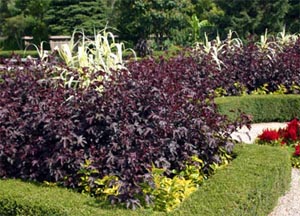
Most people grow Hibiscus plants for their showy flowers – the exotic ones you envision on tropical islands. There is one species, however, that is more noted for its interesting foliage than the flowers. Hibiscus acetosella is a bold addition to the garden, with deep red-purple foliage that makes a great contrast with green and silver-leaved plants. This tender perennial subshrub, native to tropical East Africa, is hardy only to zone 8 or 9 but is easily grown as an annual in colder climates. It is not often referred to by a common name but you may see it listed as African rosemallow, false roselle, maroon mallow, cranberry hibiscus or red leaved hibiscus.
The palmate leaves are dissected to varying degrees, depending on the cultivar, and in general are reminiscent of a Japanese maple. The leaves of the species are variable, lobed or unlobed, green and red or all red, but those selections offered as ornamentals have dark maroon, bronze colored, or variegated leaves and stems. The foliage is particularly attractive when backlit and the sun shines through the leaves. The plants grow 3-5 feet tall and up to 30” wide in one season.

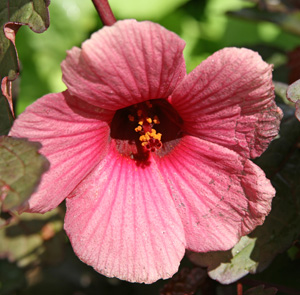
The small (2”), deep crimson to purple flowers are rather similar in color to the foliage. They are borne singly in the leaf axils, so because of both their color and location between the leaves the flowers are not very conspicuous and may be overlooked. Plants bloom in response to short day length, so they flower very late in the growing season. In the Midwest, plants are typically killed by frost before flowers appear.
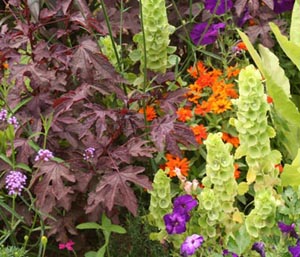
The shrubby habit of this plant makes it a good choice for a seasonal hedge, an attractive annual specimen plant, or for contrast in the mixed border or cottage garden. It looks particularly nice with the silver foliage of cardoon. Combine darker purple-red types with pink flowers, such as pentas, zinnias or Verbena bonariensis, for a sophisticated look or with lime-green foliage or green, yellow, or bright orange zinnias or other flowers for a bolder composition. Plant it in combination with large-leaves plants, like bananas or cannas, for a tropical look. They look wonderful in contrast with ornamental grasses and could even be used in a large container (but likely will require pinching or cutting back to maintain an appropriate size).
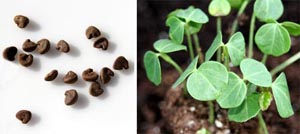
H. acetosella is easy to grow from seed and quickly attains a large size. The seeds have small prickly hairs that may be irritating to some people. Seeds germinate easily and the seedlings grow fast. Sow seed indoors 6-8 weeks before last frost. Plant outside after the danger of frost has passed. This plant is also often available as potted cuttings at nurseries and garden centers. Place in full sun in well-drained, moist soil for best growth and color. Since the plants are often not particularly full, plant several closely together to create a bushier appearance, or pinch the plants to encourage branching. If plants grow too much, they can be cut back at any time to shape the plants.
Cuttings can be taken in the fall to save plants for the next growing season. Cuttings will root in soil or water. It does well as an indoor potted plant during the winter.
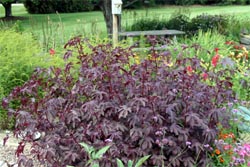
This is not a common listing in seed catalogs and might be listed by its synonym H. eetveldeanus. Several varieties are available:
- ‘Red Shield’ is the most commonly available variety, with deep purple-burgundy leaves.
- ‘Haight Ashbury’ (US PPAF), introduced by Proven Winners, has leaves whose shape bears some resemblance to marijuana, hence the name for that famous San Francisco location of the 1960s. It has variegated leaves in shades of cream, pink, red, copper and burgundy, with deep burgundy flowers. It is vegetatively propagated and not available as seed. It may be found as nursery grown stock at garden centers.
- ‘Jungle Red’ has deeply dissected, palmate leaves which resemble a red Japanese maple.
- ‘Maple Sugar’ (US PP16,286) has slightly larger burgundy-black, maple leaf-shaped foliage and burgundy blooms. It is vegetatively propagated and not available as seed. It may be found as nursery grown stock at garden centers.
- ‘Panama Bronze’ (PPAF) had deeply cut purple-bronze leaves and bright red flowers. This is a hybrid of H. radiatus x H. acetosella.
- ‘Panama Red’ (PPAF) has deeply cut red leaves and bright red flowers.
– Susan Mahr, University of Wisconsin – Madison





 Marigolds
Marigolds Create a Butterfly Garden
Create a Butterfly Garden Plant Flowers to Encourage Beneficial Insects
Plant Flowers to Encourage Beneficial Insects Forcing Bulbs
Forcing Bulbs


